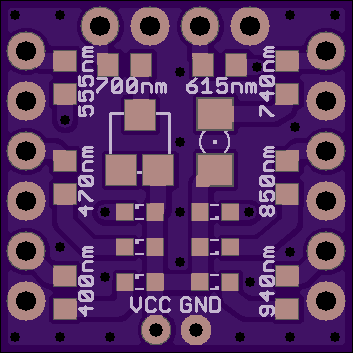April 28, 2018
I thought it would be nice to have a small device that could emit one or more narrow bands of light in the detection range of the AS7265X spectrometer, so I decided to design a simple calibration plate:

There are eight discrete narrow-band leds on the board matching within 10 nm the peaks of the spectral sensitivities of eight of the eighteen channels available in the AS7265X and spanning the full 410 - 940 nm range of the spectrometer. The board is designed to be powered by a small 3.7 V LiPo battery. Each led is turned on by connecting the appropriate current limiting resistor to ground by shunting using a simple jumper between two machine pin headers. This way one or all of the leds can be enabled just by adding or removing the shunting jumpers.
The plate could also be used on a breadboard by connecting the resistors to current sinking circuitry, etc. Perhaps this would be useful for an automated process.
I tried to limit the package sizes to 0603 but there is a gap between about ~650 nm in the red to 850 nm in the near IR where no 0603 leds could be found, so I am using one 1206 led for 740 nm and one 1212 led for 700 nm. The 850 nm and 940 nm leds in the 0603 package are new; I chose to use the 0805 package size in the spectrometer I just designed a couple of weeks ago since these were not yet available.
My plan is to simply use this board to check that all three of the spectrometers in the three-chip set are functioning and perhaps get some idea of how the spectrometer behaves with different sources of light. But reflection spectroscopy is different from emission spectroscopy, so I don't know how useful this calibration plate will end up being for testing.
The other obvious use though would be to use this calibration plate as the illumination source for reflection spectroscopy since a good measurement of the light reflected from a bright white background could be useful as a reference for identifying absorbance "lines" in unknown materials.
 Kris Winer
Kris Winer
Discussions
Become a Hackaday.io Member
Create an account to leave a comment. Already have an account? Log In.